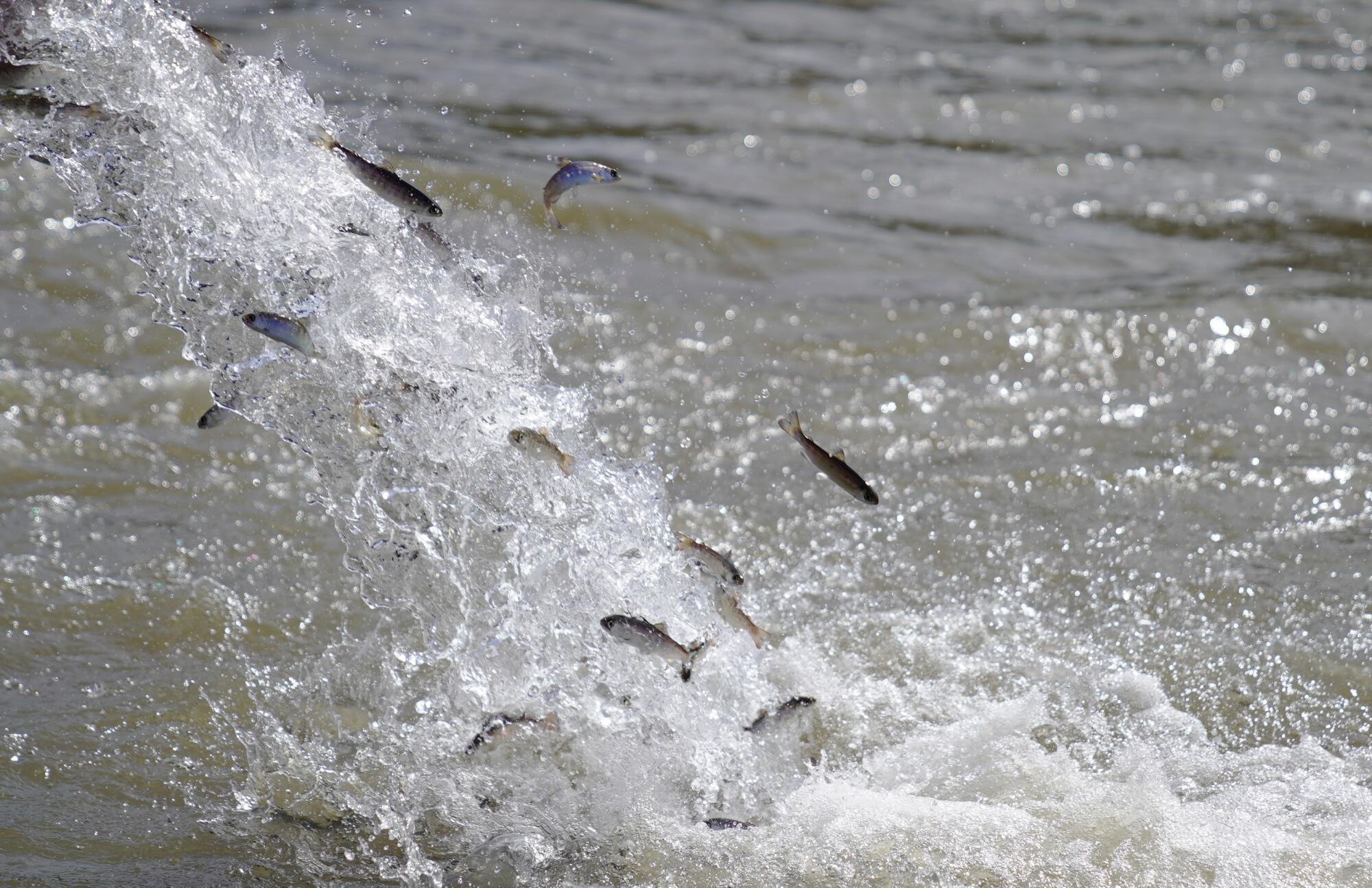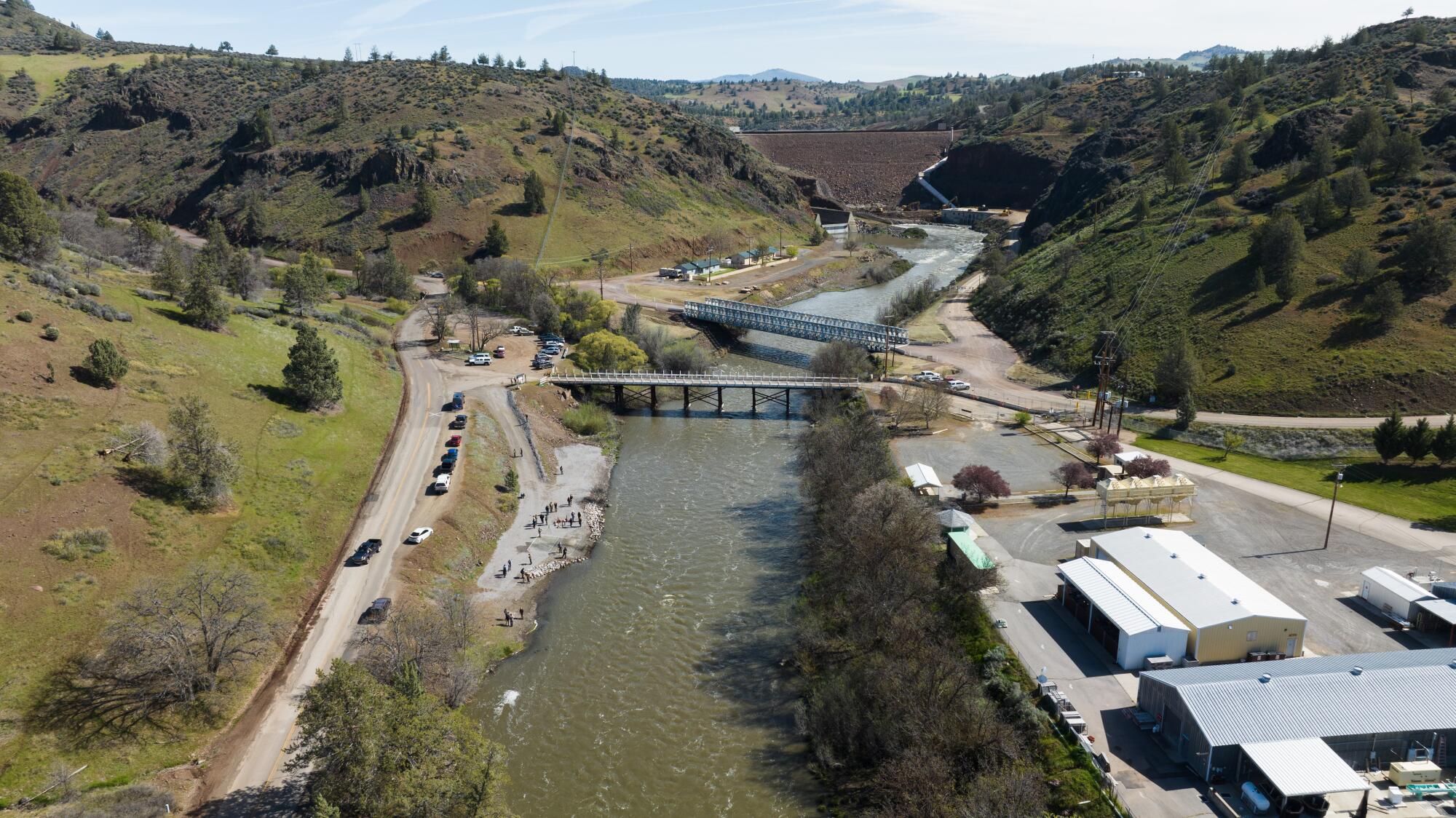While work crews continued to breach dams on the Klamath River, leaders from four tribes gathered on the riverbank last week to watch and pray as a valve opened on a tanker truck. From a slope, a stream of water filled with writhing fish flowed into the river.
Over two days, California Department of Fish and Wildlife workers freed 16 truckloads of juvenile salmon raised in a newly constructed hatchery. About 500,000 salmon swam up the river, and tribal leaders said they expected these fish to thrive when they move back upstream to spawn in the free-flowing river in a few years.
“They are symbols of hope,” said Yurok Tribal Council member Phillip Williams.
Williams said as he watched the fish disappear from the river he wondered how he and several other tribal members would be able to catch some of those salmon when they returned in three or four years.
“They’re going to feed families,” Williams said. “So it was really, really emotional.”
The young fish were raised at the Fall Creek Fish Hatchery and included approximately 90,000 coho salmon, an endangered species, as well as more than 400,000 fall-run Chinook salmon.
The last time state workers released Chinook salmon in February, they released more than 800,000 fish into a tributary of the Iron Gate Dam, which is planned to be removed, and the fish were later released. found dead in the river, Biologists determined that the salmon died when they passed through a tunnel beneath the dam.
To prevent this from happening again, state officials selected another location just below the Iron Gate Dam.

Coho salmon are released into the Klamath River in Siskiyou County on April 16.
(Matt Mace/Yurok Tribe)
They also ran a test ahead of time, in which groups of young salmon were dropped into the river in 2-foot-long plastic cylinders, called “survival cars”, to ensure that the fish would survive the journey to the ocean. The water quality was fine. That two-day test confirmed that the fish were healthy in the river.
This time, state officials said the release was a complete success.
Kenneth Brink, vice chairman of the Karuk tribe, sang as a stream of water filled with fish flowed into the river in front of the dam. Others prayed.
Brink said, “This river is our church, and that salmon is the cross of that church.”
“Seeing the salmon come back, seeing their religion come back and being able to live as the Karuk people is going to be a very, very healing experience,” he said in a video recorded after the release. , “It’s like a new beginning.”
Leaders with the Shasta Indian Nation and Quartz Valley Indian Tribe also watched as the salmon headed downstream.
It was the first major release of coho salmon in Klamath since work began to remove four dams last year.
Water is now flowing through tunnels into three remaining dams and reservoirs near the California-Oregon border that once inundated the valleys has been drained,
Work crews are blasting and demolishing a concrete dam. Sometime this fall, the dams are planned to be completely removed, reestablishing the free flow of the river for the first time in more than a century. Once the dam is finished, salmon will be able to swim upstream and spawn in nearly 400 miles of the Klamath and its tributaries.
Some of the released fish are expected to return as adults within a few years to the Fall Creek Fish Hatchery, a $35 million facility built as part of a dam removal agreement between California, Oregon and PacifiCorp, the utility that operates the dams. Was created as. ,

People gathered on the banks of the Klamath River on April 16 to watch as hatchery-raised salmon were released downstream of the Iron Gate Dam, which is scheduled to be removed this year.
(Jason Hartwick/Swiftwater Films)
It is also expected that some fish will be among the first to spawn in the wild along sections of the river that were previously closed off by dams.
“These fish will be the fish that will help the population recover,” said Charlton “Chuck” Bonham, director of the California Department of Fish and Wildlife.
This winter season caused floods due to drying up of reservoirs dirty, sediment-laden water Flowing downwards. The sudden drop in water quality caused the amount of oxygen in the water to drop, leading to the death of fish including non-native perch, bluegill and bass introduced into the reservoir.
State tests have shown that river conditions have improved and are now suitable for salmon to thrive, Bonham said. “The releases over the past few days show the river is good and will continue to get better.”
Later in the spring, state hatchery managers plan to release about 2 million Chinook salmon smolts into the river.
Scientists hope the $500 million dam removal project, the largest in history, will help boost salmon populations in the coming years.
Salmon populations have declined in recent years, and fishing for Chinook salmon has declined. California coast is banned This year for the second year in a row.
Leaders of the Yurok and Karuk tribes plan to decide soon how much, if any, fishing they will allow this year.

















